Engravings of the year 1634
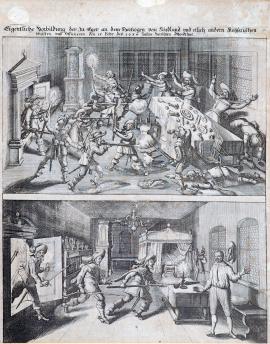
A real depiction of the assassination committed in Cheb on 15 February 1634 on the Duke of Friedland and several other Imperial colonels and officers.
The engraving is separated into two parts down the middle. The top part shows the assassination of the officers and supporters of the Duke of Friedland. There is a dining hall filled with many fighting and shooting men, the tables are full of food, the tablecloth is pulled off. The other part of the print portrays Wallenstein in his nightdress. He is standing in the bedroom, with a desk with a burning candle in the background. A four-posted canopy bed is in the corner of the room. Three soldiers are breaking through the door, the first one (Deveroux) is just about to stab Wallenstein with a halberd, a stabbing double-edge weapon with a long shaft. Others are armed by cords.
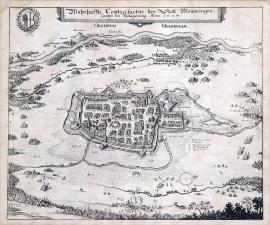
A true depiction of the town of Memmingen including its siege that took place in the year 1634.
The siege of Memmingen is depicted in the centre of the print. The river Iller and the stream Buxach flow nearby. There is a main tent of the Swedish Marshal Gustav Horn on the bank of the river at the top right. The above-stated text is above the picture in an oblong cartouche, the coat-of-arms of Memmingen is on the left, with a laurel wreath wrapped around it. The engraving is remarkable for its delicate work.
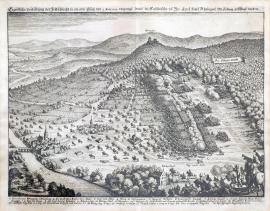
An original depiction of a field battle in the Upper Alsace on 2 March 1634 where His Excellency Count Otto Louis of Rhineland defeated the Imperial regiments.
The print depicts the battle between the Imperial and Swedish regiments. A thick forest inscribed: ‚Der Löwen Wald‘ is on the right, in the background is the Chateau Hirtenstein with the river Thur flowing below. The battle of the two armies is in the centre of the picture. The Imperial regiments are fleeing towards the left side of the print. A horse cavalry with buglers is at the bottom right. The caption 1-21 is below the picture, while the German text is above it.
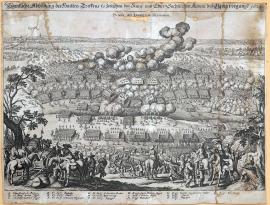
An original depiction of a tough battle fought between the Imperial and Electorate-Saxon armies near Legnica in 1634.
Huge battle turmoil, partially veiled by the smoke from cannons, fills the entire area of the print. The town of Legnica is in the left background. There are some minor military scenes in the foreground drawn with great mastery. The German text is above the picture while the caption A – Q is below it.
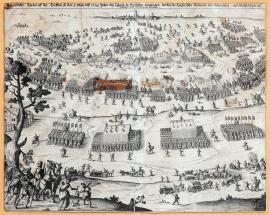
An original drawing of a battle fought on 3 May of the year 1634 near Legnica in Silesia, in which the Imperial army was defeated and scattered around by the Swedish-Saxon army.
The town of Legnica in Silesia is portrayed at the very top of the picture. Imperial soldiers are fleeing in the direction of the town. The rest of the painting is filled up by the army formations lined-up in typical squares. In the left foreground are a large tree, 2 cavalrymen, 3 soldiers, a woman with a child and a farmer holding a dog and a hen in his hands.
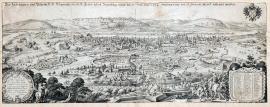
The siege of the Imperial free city of Regensburg carried out by His Royal Majesty of Hungary and Bohemia, initiated on 15 May 1634 and ended by agreement on 17 July.
This is a large representative copper engraving, which depicts the siege of Regensburg by the Imperial army. There are mountains and the river Danube in the background. The town itself is engraved very clearly and meticulously. There are some military scenes, fortification walls, army camps etc. in the foreground. A factual and topographical captions, A-Z and 1-29, are in an ornamental banner on the right. Nearby are individual cavalrymen and musketeers carrying standards. On the left is a round ornamental cartouche with the coats-of-arms of the city council including a dedication to an unnamed burgomaster by a certain Matthias Hubert. The coat-of-arms of Regensburg, a two-headed eagle with crossed keys is at the top right. The German text cited word-for-word on the previous page is placed in the clouds over the depicted city.
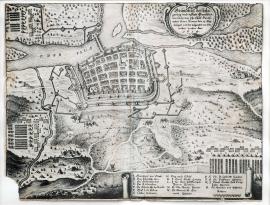
A ground-plan of the siege of the city of Frankfurt, which was besieged by His Excellency Electorate, apart from the General Banner on 13 May, and was conquered on 23 May. In the year 1634.
The print shows the situation (ground-plan) of Frankfurt on the river Oder. The wide flow of Oder spanned by a bridge near Frankfurt cuts off symbolically the top left corner of the print. The town is surrounded by the enemy’s regiments with numerous cannon batteries and army camps. The stated German text is placed in an ornamental cartouche at the top right. The topographic and military caption A-R is above the picture part of the print, included is also a scale in rutheny.
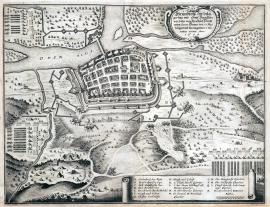
A ground-plan of the siege of the city of Frankfurt, which was besieged by His Excellency Electorate, apart from the General Banner on 13 May, and was conquered on 23 May. In the year 1634.
The print shows the situation (ground-plan) of Frankfurt on the river Oder. The wide flow of Oder spanned by a bridge near Frankfurt cuts off the top left corner of the print. The town is surrounded by the enemy’s regiments with numerous cannon batteries and army camps. The stated German text is placed in an ornamental cartouche at the top right. The topographic and military caption A-R is above the picture part of the print, included is also a scale in rutheny.
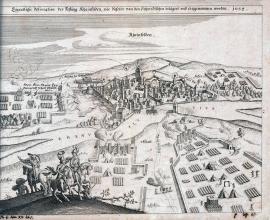
An original outline of the fort of Rheinfelden, which was besieged and conquered by the Swedish. 1634.
The town of Rheinfelden with its high church spire is outlined in the centre of the engraving. Outside the town is: ‚Herr Gen. Maior Exc. Reingraff Johann Philips quartier‘, and nearby to the right: ‚ Auszug der Kayserlichen‘. There are mountain ridges in the background. The river Rhine flows across the painting. Army camps and cannon batteries are in the foreground. There are even ballistic tracks of the cannonballs falling on the town outlined. In the left foreground are three cavalrymen.
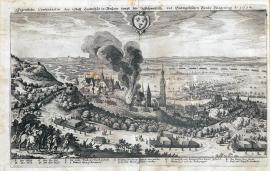
An original depiction of the town of Landshut in Bavaria besieged by the Swedish - Evangelic Federation, in the year 1634.
The engraving shows the town of Landshut in a beautifully drawn countryside. A huge fire broke out in the town, covering it with clouds of smoke. The Imperial army is running away on the other bank of the river Isar. There are 2 cavalry and some infantry soldiers in the left foreground. The coat-of-arms of Landshut with three hats is drawn above the town. The caption A-L is at the bottom..
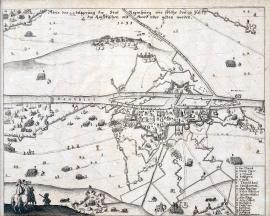
An outline of the siege of the town of Regensburg, which was handed over according to agreement to the Imperial army in 1634.
The Danube river flows across the picture with the town of Regensburg along its banks. The river Regen, which spills into branches in the Bavarian part of the Bohemian Šumava Forest, flows into the Danube from the left side. Two cavalrymen are portrayed in the left foreground. The Imperial army camp inscribed: ‚Königs in Ungern Läger‘ is in the top left corner. The caption A-S is at the bottom left.
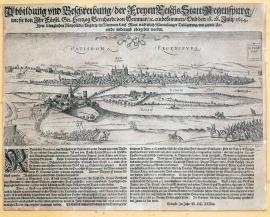
A depiction and a description of the free Imperial city of Regensburg, which was captured by His Excellency Count Duke Bernhard of Weimar, and following a siege lasting several months by his Majesty in Hungary on behalf of his Imperial Majesty handed over again upon a good agreement on 28 July 1634.
The city of Regensburg on the river Danube with an island and two bridges lies in the background of the engraving. Its suburb with two high spires is on the left. The Swedish army is just retreating from it. A cavalry regiment is at the bottom right. A small banner with the inscription: ‚Bischofspalast‘ is placed above it. The coat-of-arms of the city (two crossed keys) and an inscription: ‚Ratisbona- Regenspurg‘ is in the sky over the city.

Nördlingen in the Imperial Swabia.
The print shows the overall view of the city of Nördlingen situated in the Western Bavaria near the border with Württemberg, approx. 80 km northwest of Augsburg. There is an unrolled ribbon banner in the sky over the landscape with the French inscription stated on the previous page. There are several military regiments with carriages in the foreground. A high officer with a report giving adjutant is depicted on the left. A large tree stands nearby and there is a church on a hillock on the right. The caption A-V is below the picture. This is a copper engraving of French origin of a high artistic quality. Although there is no signature, it shows many characteristics of the engraving techniques of Jacques Callot. It is remarkable that apart from the topographical caption the position of Nördlingen and its surrounding is also given according to modern cartographic customs in the longitudes and latitudes.
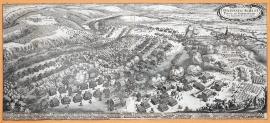
An outline of an army formation and the Battle of Nördlingen on 6 September 1634.
This wide print depicts the Battle of Nördlingen. The Imperial army is on the right side and the Swedish on the left in a forest. The city of Nördlingen is painted nearby on the right. A small scene with a colonel and buglers is depicted in the right foreground. The entire area of the print is filled up by fighting regiments. The Latin inscription cited word-for-word on the previous page is placed in an ornamental cartouche at the top right. The caption A-Z and 1-42 is below the picture.


